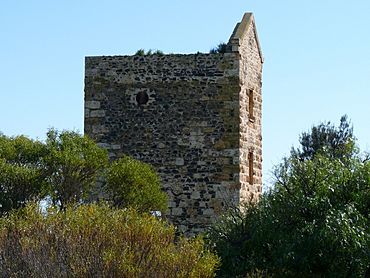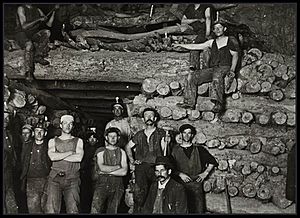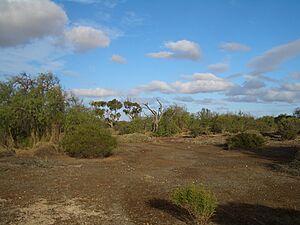Wallaroo Mines, South Australia facts for kids
Quick facts for kids Wallaroo MinesKadina, South Australia |
|||||||||||||||
|---|---|---|---|---|---|---|---|---|---|---|---|---|---|---|---|

Harvey's Pumping Station
|
|||||||||||||||
| Established | 1860 | ||||||||||||||
| Postcode(s) | 5554 | ||||||||||||||
| LGA(s) | Copper Coast Council | ||||||||||||||
| State electorate(s) | Narungga | ||||||||||||||
| Federal Division(s) | Grey | ||||||||||||||
|
|||||||||||||||
| Footnotes | Coordinates | ||||||||||||||
Wallaroo Mines is a small area near the town of Kadina in South Australia. It's located on the Yorke Peninsula, an area known for its copper mining history. The name "Wallaroo Mines" comes from the land area where it was started in 1860. This area was called the Hundred of Wallaroo. The nearby coastal town of Wallaroo also got its name from this same land division. The official borders for Wallaroo Mines were set in January 1999, keeping its long-known name.
Contents
History of Wallaroo Mines
When British settlers arrived in the late 1830s and 1840s, they used the land for grazing animals. However, no lasting towns were built there at first.
Discovery and Early Growth
On December 17, 1859, a shepherd named James Boor made an exciting discovery. He found copper on the Wallaroo sheep farm, which belonged to Walter Watson Hughes. Soon after, many men started working at the site. By August 1860, the new copper mines had 150 workers. They were digging up "rich quality" copper ore. By the end of 1860, about 500 people lived there.
The mines quickly grew. They had an enginehouse, an office, and homes for the mine captain and secretary. There was also a special office to test the copper ore. The mining company even had its own store for the miners. Because the mines were growing so fast, the town of Kadina was planned in 1860. The first land plots in Kadina were sold in March 1861. The mine owners created a company called the Wallaroo Mining Company in August 1860. Edward Stirling was the first leader of this company.
A small community quickly formed around the mine in 1860. It was a mix of miners' homes, sheds, and mine buildings. A church for Primitive Methodists was built in 1861. A temporary courthouse, made of canvas, was moved from the mines to Kadina in April 1861. A police station, described as a "gipsy tent," followed in January 1862.
In June 1862, a special railway opened. It was run by horses and connected the mines to the port at Wallaroo. There was also a branch line into Kadina. The government later bought this railway in 1878. A steam train line from Adelaide arrived the same year. The old horse-drawn line was then removed. More churches were built, including a Bible Christian church in 1866 and a Wesleyan Methodist Church in 1867.
Peak Mining Years and Challenges
The Wallaroo Mines were busiest between 1870 and 1875. During this time, up to 1000 people worked there. Wallaroo Mines Primary School opened on January 31, 1878. It was the first public school in the Kadina area. The mine had to close for a while from 1878 to 1880. This happened because copper prices were very low. Many people left the area during this time. The mine worked with fewer operations through most of the 1880s. The Wallaroo Mines Post Office opened on July 1, 1890.
In 1889–90, the Wallaroo Mine joined with the Moonta Mine. They formed a new, bigger company called the Wallaroo and Moonta Mining and Smelting Company. This became the largest industrial business in South Australia. Before they joined, the Wallaroo Mine had produced a huge amount of copper. In 1900, there was an outbreak of typhoid at Wallaroo Mines. A new doctor said the town's hygiene was very bad. So, the mining company made many improvements. They also brought in main water pipes.
The Wallaroo Mines Institute was built by the mining company in 1902. In 1904, a fire broke out in Taylor's Shaft, a main part of the mine. The fire lasted over a month and cost a lot of money. This led to a "modernisation program" for the mine. The number of people working at the mine reached its highest point in 1906, with 2700 employees.
The Mines Close Down
After World War I, the mines faced difficulties. The price of copper went down, causing the mines to close for long periods. They lost a lot of money between 1919 and 1922. In November 1923, the mining company officially closed down. The mine shut its doors for good. Over its lifetime, the mine produced about 165,000 tonnes of copper.
The closure of the mine greatly affected the Kadina area. Many people moved away. This led to several churches and other facilities closing down. The Elders Engine House was taken apart. Its stones were used in 1936 to build the new Kadina Catholic Church. The Primitive Methodist church was also taken down in 1927. The old Bible Christian church was demolished in the late 1930s. It had been used as a community hall and cinema before that.
Wallaroo Mines had a football club called the "Federal Rovers." But the league stopped playing in 1936. A small store on Lipson Road was run by Will Harwood starting in 1920. The original school building closed around 1967 and was demolished in 1977. The Wallaroo Mines Post Office closed on April 30, 1976. The Wallaroo Mines Methodist Church building was demolished in 1980. The church then moved into the Wallaroo Mines Institute. In 1988, a plant was built to process copper ore. It was on the old school site. However, this plant closed by 1992.
Wallaroo Mines Today
Today, you can explore the old Wallaroo Mines site on a self-guided walking trail. The old Harvey's Pumping Station, built in 1874, is still standing. It's the last of the mine's pumping stations left. This building is listed on the South Australian Heritage Register as an important historical site.
The Kadina Heritage Trail also points out other interesting spots. These include the site of an old cemetery from 1860. You can also see where the Methodist Church used to be. The trail shows the former police residence and the old post office. You can find the mine's explosives storage building. There are also ruins of the mine manager's home and other old houses. The site of the Devon mine is also noted. Wallaroo Mines Primary School is still open today. It's in a new location north of the original site. In 2015, 102 students were enrolled there.




